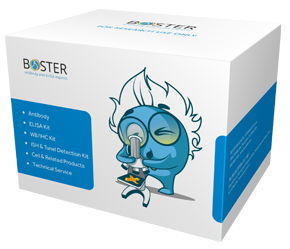Product Info Summary
| SKU: | EKC1534 |
|---|---|
| Size: | 1 kit, containing one 96-well plate and all necessary reagents |
| Reactive Species: | Human, Mouse, Rat |
| Application: | ELISA |
Customers Who Bought This Also Bought
Product info
Product Name
Sodium Channel-pan Colorimetric Cell-Based ELISA Kit
SKU/Catalog Number
EKC1534
Size
1 kit, containing one 96-well plate and all necessary reagents
Description
The Sodium Channel-pan Cell-Based ELISA Kit is a convenient, lysate-free, high throughput and sensitive assay kit that can monitor Sodium Channel-pan protein expression profile in cells. The kit can be used for measuring the relative amounts of Sodium Channel-pan in cultured cells as well as screening for the effects that various treatments, inhibitors (ie. siRNA or chemicals), or activators have on Sodium Channel-pan.
Storage & Handling
Store at 4°C for up to 6 months.
Cite This Product
Sodium Channel-pan Colorimetric Cell-Based ELISA Kit (Boster Biological Technology, Pleasanton CA, USA, Catalog # EKC1534)
Clonality of Antibodies
See Datasheet for details
Assay Range
> 5000 cells/well
Reactive Species
EKC1534 is reactive to SCN1A in Human, Mouse, Rat samples
Application Guarantee
EKC1534 is guaranteed for ELISA in Human, Mouse, Rat by Boster Guarantee
See how Boster Bio validate our ELISA kits: ELISA Validation Information
Kit Components
| Reagent | Quantity | Container |
|---|---|---|
| 96-Well Cell Culture Clear-Bottom Microplate | 1 Plates | - |
| 10x TBS | 24 ml (10x) | Clear |
| Quenching Buffer | 24 ml (1x) | Clear |
| Blocking Buffer | 50 ml (1x) | Clear |
| 15x Wash Buffer | 50 ml (15x) | Clear |
| 100x Anti-Sodium Channel-pan Antibody (Rabbit Polyclonal) | 60 µl (100x) | Purple |
| 100x Anti-GAPDH Antibody (Mouse Monoclonal) | 60 µl (100x) | Green |
| HRP-Conjugated Anti-Rabbit IgG Antibody | 6ml (1x) | Glass |
| HRP-Conjugated Anti-Mouse IgG Antibody | 6ml (1x) | Glass |
| Primary Antibody Diluent | 12 ml (1x) | Clear |
| Ready-to-Use Substrate | 12 ml (1x) | Brown |
| Stop Solution | 12 ml (1x) | Clear |
| Crystal Violet Solution | 6ml (1x) | Glass |
| SDS Solution | 24 ml (1x) | Clear |
| Adhesive Plate Seals | 2 Seals | - |
*The kit components are not available for individual purchase.
Materials Required But Not Included In Kit
- Microplate reader able to measure absorbance at 450 nm and/or 595 nm for Crystal Violet Cell Staining (Optional)
- Micropipettes with capability of measuring volumes ranging from 1 ul to 1 ml
- 37% formaldehyde (Sigma Cat# F-8775) or formaldehyde from other sources
- Deionized or sterile water
- Squirt bottle, manifold dispenser, multichannel pipette reservoir or automated microplate washer
- Graph paper or computer software capable of generating or displaying logarithmic functions
- Absorbent papers or vacuum aspirator
- Test tubes or microfuge tubes capable of storing 1 ml
- Orbital shaker
- Poly-L-Lysine (Sigma Cat# P4832 for suspension cells)
Data Examples, Quality Control Data

Click image to see more details
Boster Kit Box

Click image to see more details
Western blot analysis of extracts from HuvEc cells
Protein Target Info & Infographic
Gene/Protein Information For SCN1A (Source: Uniprot.Org, NCBI)
Gene Name
SCN1A
Full Name
Sodium channel protein type 1 subunit alpha
Weight
228972 MW
Superfamily
sodium channel (TC 1.A.1.10) family
Alternative Names
Sodium channel protein type 1 subunit alpha;Sodium channel protein brain I subunit alpha;Sodium channel protein type I subunit alpha;Voltage-gated sodium channel subunit alpha Nav1.1;SCN1A;NAC1, SCN1; SCN1A DEE6, DRVT, EIEE6, FEB3, FEB3A, FHM3, GEFSP2, HBSCI, NAC1, Nav1.1, SCN1, SMEI sodium voltage-gated channel alpha subunit 1 sodium channel protein type 1 subunit alpha|sodium channel protein type I subunit alpha|sodium channel protein, brain I alpha subunit|sodium channel voltage gated type 1 alpha subunit|sodium channel, voltage-gated, type I, alpha polypeptide|sodium channel, voltage-gated, type I, alpha subunit|voltage-gated sodium channel subunit alpha Nav1.1
*if product is indicated to react with multiple species, protein info is based on the gene entry specified above in "species".For more info on SCN1A, check out the SCN1A Infographic

We have 30,000+ of these available, one for each gene! check them out.
In this infographic you will see the following information for SCN1A: database IDs, super-family, protein function, synonyms, molecular weight, chromosomal locations, tissues of expression, subcellular locations, post translational modifications, and related diseases, research areas & pathways. If you want to see more information included, or would like to contribute to it and be acknowledged, please contact us [email protected].
Specific Publications For Sodium Channel-pan Colorimetric Cell-Based ELISA Kit (EKC1534)
Hello CJ!
EKC1534 has been cited in 1 publications:
*The publications in this section are manually curated by our staff scientists. They may differ from Bioz's machine gathered results. Both are accurate. If you find a publication citing this product but is missing from this list, please let us know we will issue you a thank-you coupon.
Cao Y,Wang Y,Xiao L,Xu JY,Liu Y,Jiang R,Li T,Jiang J.Endothelial-derived exosomes induced by lipopolysaccharide alleviate rat cardiomyocytes injury and apoptosis.Am J Transl Res.2021 Mar 15;13(3):1432-1444.PMID:33841668;PMCID:PMC8014340.
Species: Rat
EKC1534 usage in article: APP:CELL VIABILITY ASSAY, SAMPLE:CMS, DILUTION:NA
Recommended Resources
Here are featured tools and databases that you might find useful.
- Boster's Pathways Library
- Protein Databases
- Bioscience Research Protocol Resources
- Data Processing & Analysis Software
- Photo Editing Software
- Scientific Literature Resources
- Research Paper Management Tools
- Molecular Biology Software
- Primer Design Tools
- Bioinformatics Tools
- Phylogenetic Tree Analysis
Customer Reviews
Have you used Sodium Channel-pan Colorimetric Cell-Based ELISA Kit?
Submit a review and receive an Amazon gift card.
- $30 for a review with an image
0 Reviews For Sodium Channel-pan Colorimetric Cell-Based ELISA Kit
Customer Q&As
Have a question?
Find answers in Q&As, reviews.
Can't find your answer?
Submit your question



